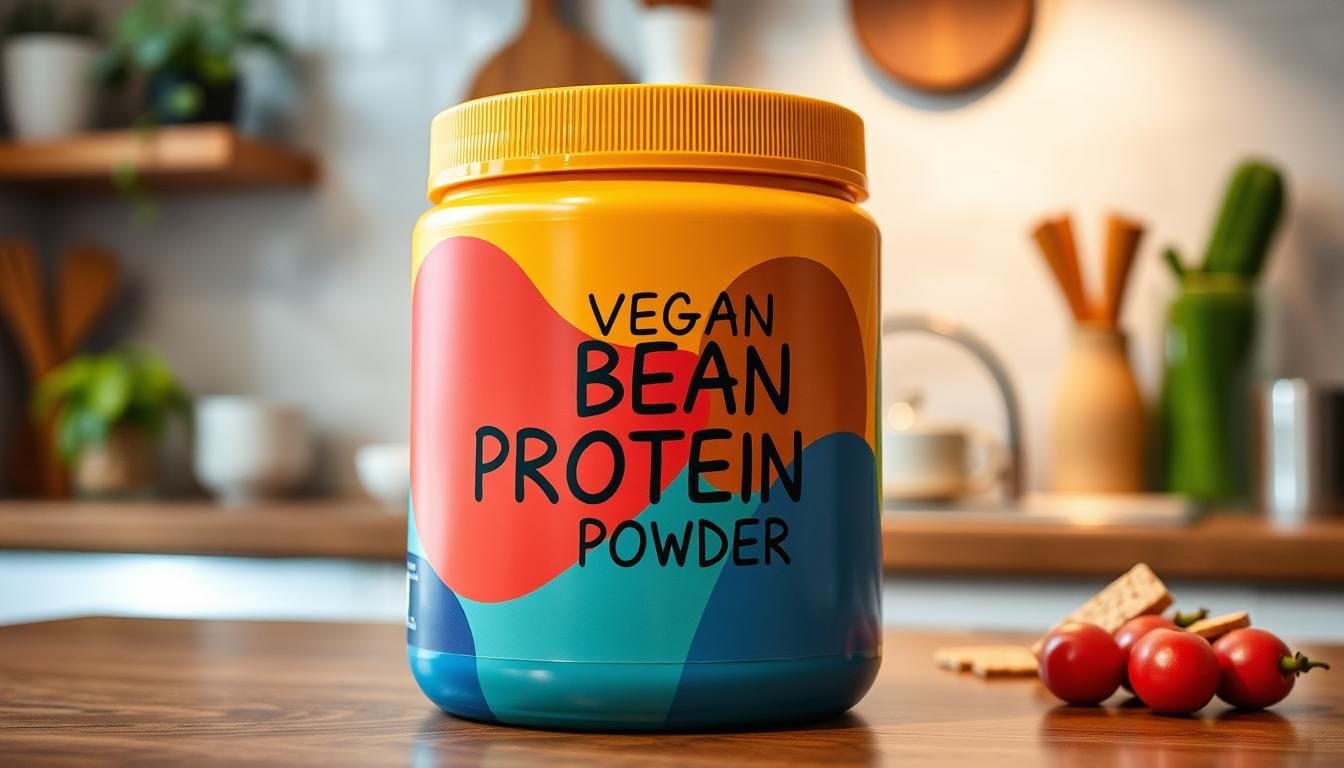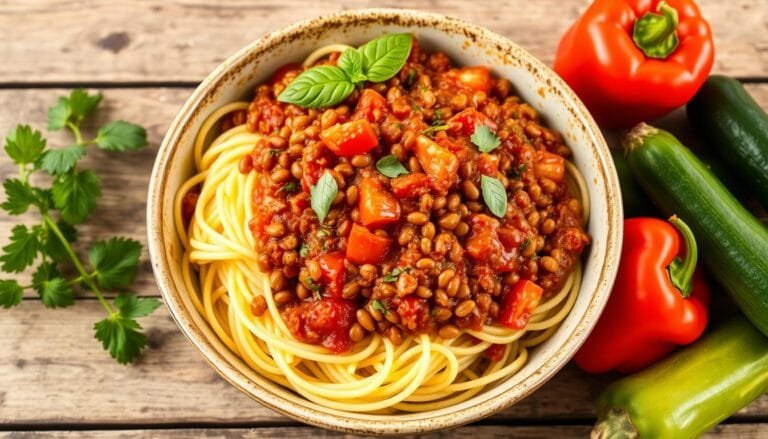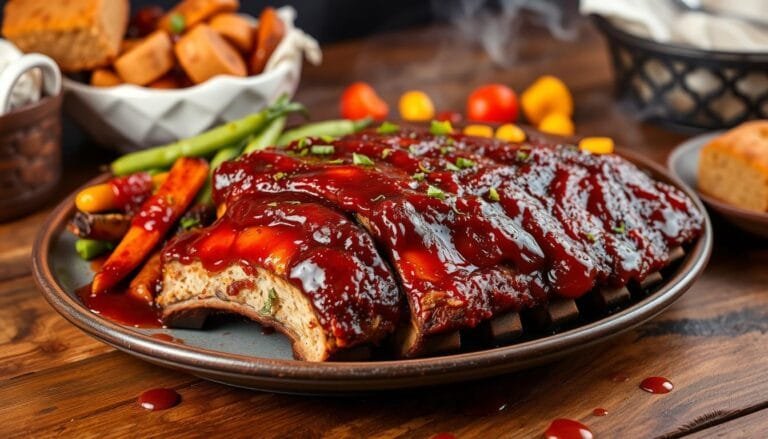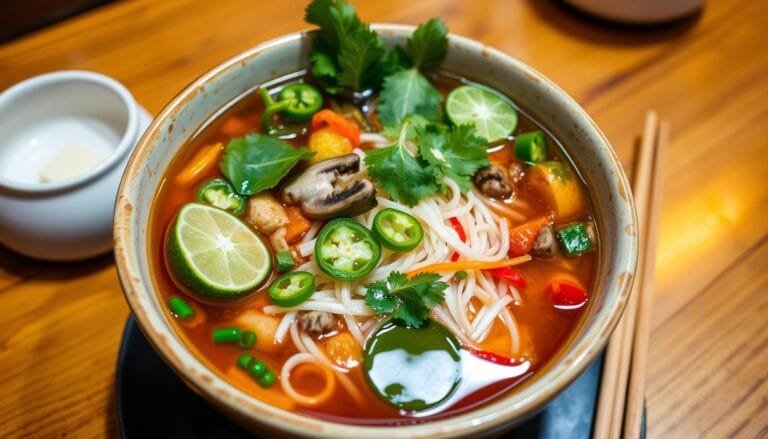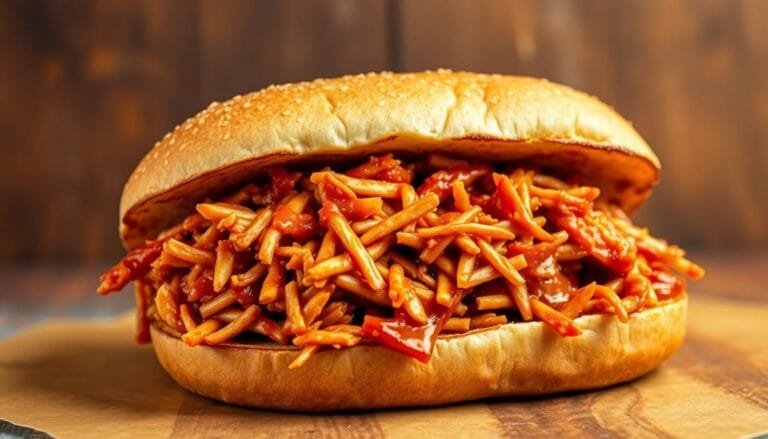I’ve found that plant-based protein powders are super versatile in the kitchen. They can make many recipes, from sweet treats to savory dishes, much healthier. This guide will show you how to use these powders to make your meals more protein-rich.
We’ll look at the different types of plant-based proteins and their health benefits. You’ll learn how to mix them into your cooking. This will help you make tasty, protein-filled meals that fit your diet and health goals.
Let’s start this fun journey into plant-based protein cooking. Every dish can be a tasty way to celebrate a healthier lifestyle.
Understanding Plant-based Protein Powder Basics
More people are choosing plant-based diets, making vegan protein sources popular. Plant-based protein powders are a convenient way to add quality protein to your meals. They come from different sources, each with its own nutritional benefits.
Types of Plant-based Proteins Available
Here are some common plant-based protein powder sources:
- Pea protein – It’s rich in iron and amino acids, great for muscle recovery.
- Hemp protein – It has omega-3 fatty acids and is easy to digest, making it a balanced choice.
- Rice protein – It’s hypoallergenic and easy to digest, perfect for those with sensitivities.
Protein Content and Nutritional Benefits
Each plant-based protein powder has its own nutritional profile. For instance, pea protein has more protein than hemp or rice. Yet, all are good vegan protein sources, providing essential amino acids and other nutrients. When picking a plant protein powder, think about what you need and like.
Common Sources: Pea, Hemp, and Rice Protein
Pea, hemp, and rice proteins are top choices for plant protein powders. They can replace whey protein in many recipes, adding variety to a vegan diet. Adding these vegan protein sources to your diet can boost energy, aid in muscle recovery, and enhance overall health.
“Shifting from an omnivore diet to veganism reduced personal greenhouse gas emissions by 50% according to a 2019 study.”
Essential Kitchen Equipment for Protein Powder Cooking
As a vegan for a long time, I’ve gathered key kitchen tools. These make cooking with plant-based protein powders easy. From blenders to measuring tools, they’re vital for tasty, protein-rich meals and snacks.
A high-speed blender is a must for protein powder prep. It blends powders into smoothies, shakes, and batters for baked goods. Choose a blender that can handle frozen fruit and nut butters well.
A food processor is also very useful. It chops, slices, and shreds ingredients for protein-rich dishes. A 3.5-cup food processor is great for small recipes.
- Measuring cups and spoons: Accurate measurements are key when working with protein powders to ensure the right balance of ingredients.
- Digital kitchen scale: For even more precision, a digital scale helps me weigh ingredients like protein powders and flours for baking.
- Silicone spatulas: These flexible tools are perfect for thoroughly mixing protein-enhanced batters and scraping every last bit from the bowl.
- Non-stick baking sheets and pans: Essential for baking protein-packed muffins, cookies, and other treats without sticking.
My vegan kitchen also has a fine mesh strainer, a can opener, and sharp knives. With the right tools, cooking with protein powder is easy. This lets me make healthy, tasty plant-based meals with ease.
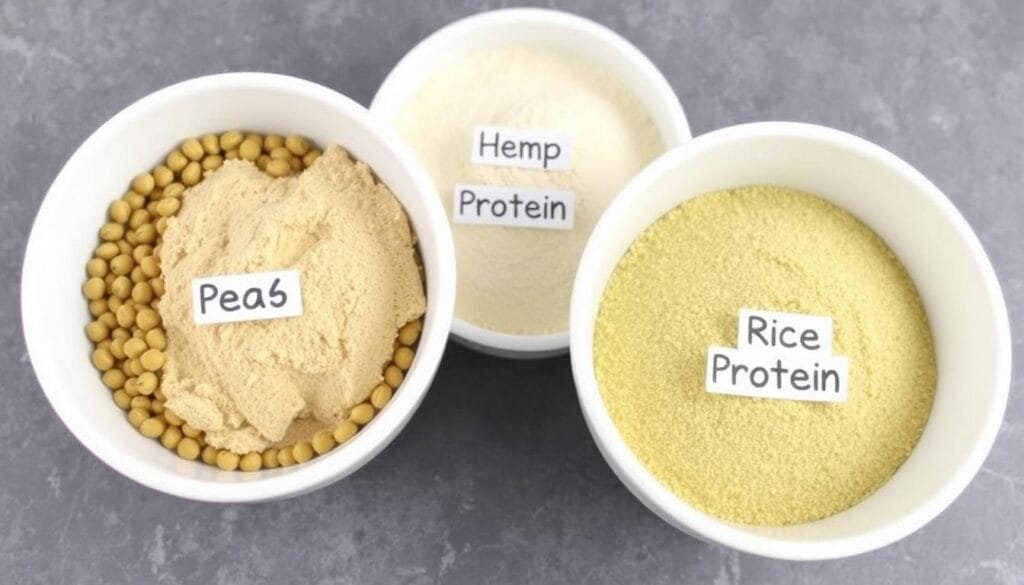
Cooking with Plant-based Protein Powder: Core Principles
When you start using plant-based protein powder in your cooking and baking, it’s key to know a few basics. Understanding temperature and the right mix of liquid and powder is essential. These tips will help make sure your dishes always come out right.
Temperature Considerations
Plant-based protein powders, like pea, hemp, and rice, handle heat differently than whey. Vegetable-based powders are great for soups, sauces, and slow-cooked meals because they don’t curdle. Keep an eye on the heat and time to keep your protein powder smooth and soluble.
Liquid-to-Powder Ratios
Finding the right mix of liquid and protein powder is important. Start with a 1:1 ratio and adjust as you go. Too much protein powder can make your dish gritty, so experiment to get it just right.
Mixing Techniques and Tips
When baking or cooking, mix the protein powder with dry ingredients first. This stops clumps and spreads the protein evenly. For a smooth mix, whisk or blend the protein powder into your dry ingredients before adding liquids.
By sticking to these basic principles, you’ll make tasty, protein-rich dishes. With a bit of practice, you’ll discover a world of tasty and healthy recipes.
Moisture Management in Protein-Enhanced Recipes
Using protein baking tips can really change your cooking game. But, managing moisture in your moist protein recipes is key. Plant-based protein powders, like pea, hemp, and rice, soak up more liquid than regular flours. This can make your baked goods dry and dense.
To fix this, tweak your recipes by adding more liquid or less dry ingredients. Try adding Greek yogurt, mashed banana, or applesauce to keep things moist. Make your batter a bit thinner than usual. This is because the protein powder will soak up more liquid as it bakes.
| Ingredient | Function |
|---|---|
| Greek Yogurt | Adds moisture and a creamy texture |
| Mashed Banana | Provides natural sweetness and moisture |
| Applesauce | Helps retain moisture and a tender crumb |
By making these adjustments, you can make tasty and moist moist protein recipes. These recipes will highlight the great taste of plant-based protein cooking.
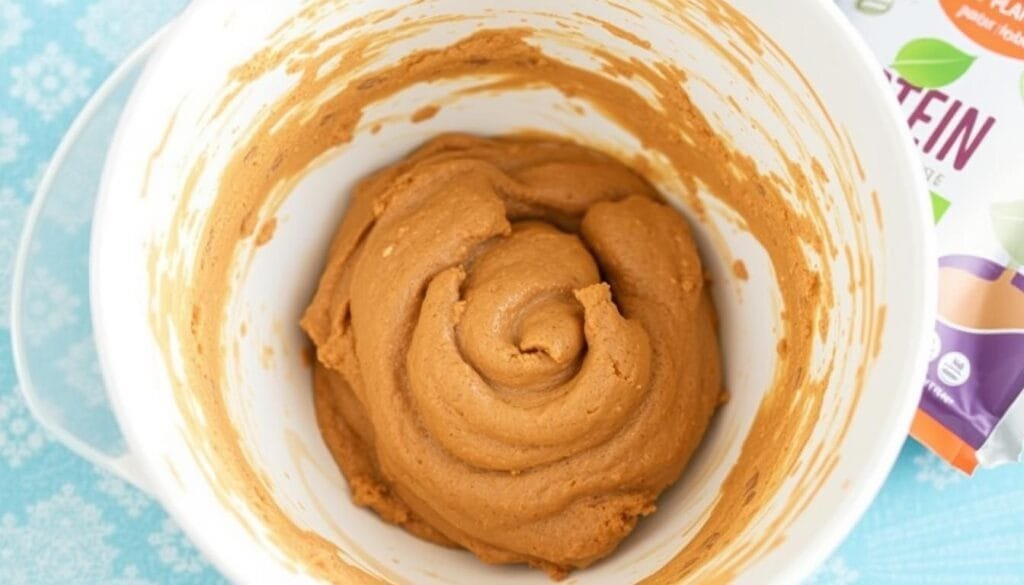
“The key to success in protein-enhanced baking is learning to manage the moisture levels in your recipes. With a few simple tweaks, you can achieve the perfect texture in protein cooking.”
Baking Science: Plant Protein vs. Traditional Flour
Exploring plant-based protein powders shows us how they differ from wheat flour in baking. These differences affect the texture, rise, and how ingredients stick together in your recipes. Knowing these differences helps you make tasty, protein-rich baked goods.
Texture Modifications
Protein powders like pea, hemp, and rice are denser and coarser than all-purpose flour. This makes baked goods heavier and more compact. To fix this, mix protein powder with regular flour for a better texture.
Leavening Adjustments
The dense nature of protein powders affects how baked goods rise. You might need more leavening agents like baking soda or powder. This helps your baked goods rise better and feel lighter.
Binding Agents and Substitutes
In gluten-free baking, protein powders are key for binding. Add xanthan gum or psyllium husk to your recipes. These help the structure and prevent dryness, mimicking gluten’s role.
Understanding plant-based protein powder in baking opens up new possibilities. Try different mixes and methods to meet your dietary and taste needs.
Sweet Applications: Desserts and Baked Goods
Plant-based protein powders can make our desserts and baked goods both tasty and healthy. We can make protein-packed pancakes and rich brownies. These ingredients open up endless possibilities in our sweet recipes.
Unflavored or flavored protein powders blend well into many desserts like muffins and cookies. We can adjust the sweetness to find the perfect balance. This way, we get a delicious treat with a protein boost.
A high-protein chocolate pudding is a great example. It’s sweet and good for you, with 10 grams of protein per serving. It’s quick to make, ready in 5 minutes, and stays fresh for 3 days.
“Plant-based proteins offer a high level of fiber, vitamins, and essential nutrients, as confirmed by the American Heart Association.”
Baking with these powders needs some trial and error. They can change how our baked goods turn out. But with some practice, we can make amazing protein desserts and healthy baked goods.
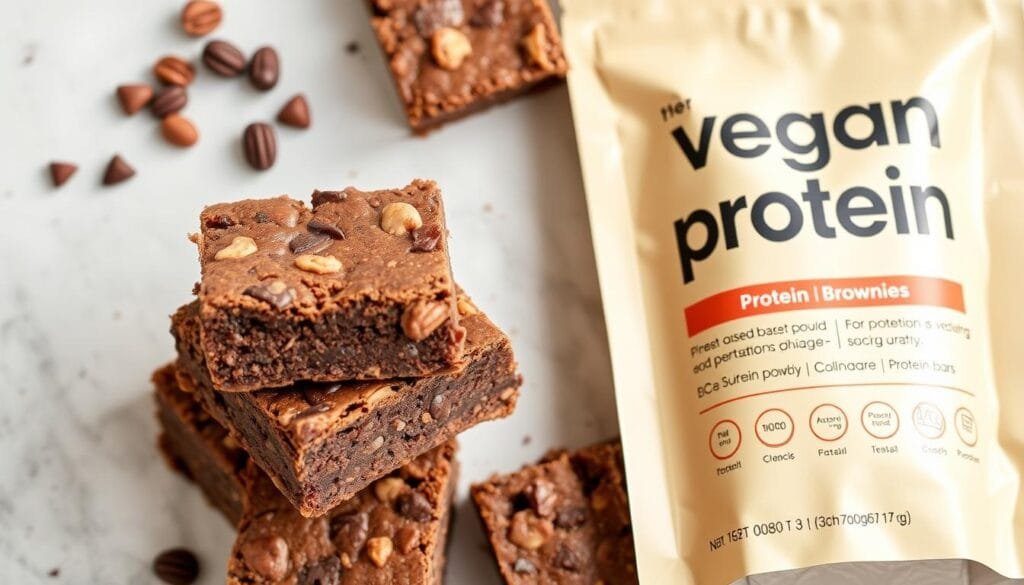
Adding plant-based protein powders to our desserts and baking is a big win. It’s great for fitness lovers, health enthusiasts, or anyone who loves sweets. It lets us enjoy high-protein sweets that are both tasty and good for us.
Breakfast Recipes and Morning Preparations
“Breakfast is the most important meal of the day,” as they say. Starting your day with high-quality, plant-based protein is key. Explore these tasty breakfast recipes that use protein powders for energy and nourishment.
Protein Pancakes and Waffles
Make your morning pancakes and waffles better by adding plant-based protein powder. This change increases protein and adds flavor and texture. Try different flavors like vanilla, chocolate, or savory to find your favorite.
Overnight Oats Variations
Overnight oats are a great, healthy breakfast choice. They go well with plant-based protein powder. Add your favorite protein powder to the oats, along with toppings like berries, nut butter, or maple syrup. This makes a protein-rich breakfast ready when you are.
| Ingredient | Protein Content |
|---|---|
| Vegan Protein Pancakes | 21.9 grams |
| 2 Eggs | 12 grams |
| 1/2 cup Greek Yogurt | 12.5 grams |
This vegan breakfast recipe has 21.9 grams of plant-based protein. That’s a lot of protein to start your day. Two eggs have 12 grams, and 1/2 cup of Greek yogurt has 12.5 grams.
Using plant-based protein powders in your morning routine is smart. You get quick protein meals and vegan breakfast ideas that keep you going. Try different recipes and toppings to find your ideal high-protein breakfast.
Savory Dishes and Main Course Applications
Plant-based protein powders open up a world of possibilities in cooking. You can make everything from hearty soups to main dishes. These meals are not only good for you but also taste amazing. Let your creativity shine and explore the savory side of plant-based protein.
Adding unflavored protein powders to soups, sauces, and gravies is easy. It thickens them naturally, adding a creamy texture. Try adding pea protein powder to your next protein-packed meals. It’s great in a savory protein recipes like Roast Cauliflower Stew or Festive Warming Soup.
For a heartier plant-based entrees, mix protein powder into bread and pasta doughs. It makes your homemade dishes more nutritious and satisfying. Use pea, hemp, or rice protein to boost your favorite main courses.
Want a protein-rich burger? Make your own veggie patties with protein powder. Mix it with veggies, herbs, and spices. You’ll get a tasty and protein-packed meal that keeps you full.
“Savory dishes with plant-based protein powder are a game-changer in the kitchen. They add a boost of nutrition without compromising on flavor.”
Looking to thicken sauces or make main courses more filling? Plant-based protein powders are your go-to. They make your cooking adventures more exciting. Get ready to make savory protein recipes that will nourish your body and delight your taste buds.
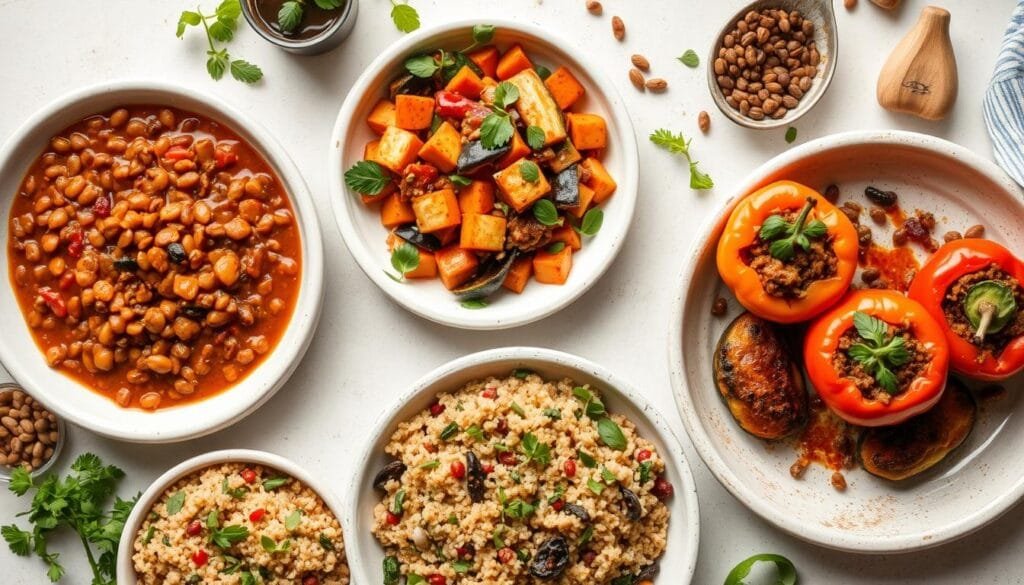
No-Bake Protein Treats and Energy Balls
Looking for a quick and nutritious snack? Try homemade protein-packed energy balls. They’re easy to make and you can customize them to your liking.
Storage Tips and Shelf Life
These protein snacks have a long shelf life. Keep them in an airtight container in the fridge for up to a week. For longer storage, freeze them for up to 3 months. They’re great for a quick energy boost anytime.
Portable Snack Ideas
- Take a few protein balls to the gym for a snack before or after working out.
- Put them in your child’s lunchbox for a healthy school-day treat.
- Take a couple with you when you’re in a hurry for a tasty, protein-rich snack.
Plant-based protein powder, nut butter, oats, and natural sweeteners make these energy bites delicious and nutritious. They keep you energized all day.
“These no-bake protein balls are a game-changer for healthy snacking. I love how you can change the flavors and they’re great for my active lifestyle.”
Need a pre-workout boost, a midday pick-me-up, or a satisfying treat after dinner? These protein snacks are perfect. Get creative with your favorite protein powder and mix-in flavors for a tasty and healthy energy bite that fits your lifestyle.
Common Cooking Mistakes and Solutions
Cooking with plant-based protein powder can make your recipes healthier. But, it also has its challenges. I’ve learned a lot from my own cooking experiences with protein powder. I’m here to share my tips to help you fix common problems.
One big issue is using too much protein powder. This can make your food dry and gritty. Start with a little protein powder and add more until it’s just right for your recipe.
Another problem is overheating the protein powder. High heat can damage the protein, losing its nutritional value. Use low to medium heat when cooking with protein powder to keep it safe.
- If your dish is too dry, add more liquid or moist ingredients next time.
- Watch the cooking time and temperature to avoid protein damage.
- Try different protein powder types and blends to find what works best for you.
Remember these tips to avoid common mistakes. You’ll make tasty, protein-rich dishes without any trouble.
| Recipe | Protein per Serving |
|---|---|
| Mini Protein Bar | 7 grams |
| Protein Bar | 10 grams |
| Protein Bar (with powder added) | 10 grams |
| Protein Ball | 5 grams |
| Protein Ball (with powder added) | 5 grams |
| Protein Muffin | 9 grams |
| Protein Muffin | 7 grams |
| Protein Pancakes (2 pancakes) | 12 grams |
| Protein Waffle | 25 grams |
| Protein Cookie (large) | 15 grams |
| Protein Cookie | 7 grams |
“Cooking with protein powder is considered 100% safe, akin to cooking meats or eggs.”
Keep these tips in mind and try different protein powders. You’ll make delicious, protein-rich dishes without any trouble.
Quality Selection and Storage Guidelines
When picking protein powder, quality matters a lot. Choose natural, high-quality powders without fillers or artificial sweeteners. Go for non-GMO and organic types for the best taste and health benefits.
Storing protein powder right is also important. Keep it in a cool, dry spot, away from sunlight. Use a sealed container to keep it fresh and protect it from moisture and other factors.
Most plant-based protein powders can last up to two years if stored correctly. Always check the expiration date. If it smells bad or looks different, it’s time to throw it away.
| Protein Powder Type | Typical Shelf Life |
|---|---|
| Whey Protein | 6-24 months |
| Pea Protein | 12-24 months |
| Brown Rice Protein | 12-24 months |
| Egg Protein | 6-12 months |
By following these easy storage tips, your protein powder will stay fresh and strong. It will be ready to make your dishes even better.
Recipe Modifications and Experimentation Strategies
Adapting recipes with plant-based protein powder is fun and rewarding. Start by replacing about 1/3 of the flour with protein powder. This keeps the texture right while adding nutrients.
Feel free to mix up the protein powder flavors. Try pea, hemp, or brown rice for new tastes. Remember to adjust the liquid to keep the right consistency.
Keep track of what works best. It might take a few tries to get it just right. But the effort is worth it for tasty, nutritious treats. With creativity, you can make endless protein-packed recipes!
